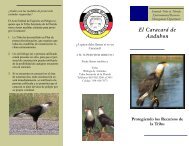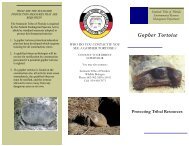Create successful ePaper yourself
Turn your PDF publications into a flip-book with our unique Google optimized e-Paper software.
The <strong>Seminole</strong> Tribune 17 <strong>April</strong> 8, 2005Agencies Partner to CurbGator Feeding, HarassingSubmitted by Bob DeGrossBIG CYPRESS — The National Park Service(NPS) and the <strong>Florida</strong> Fish and Wildlife ConservationCommission (FWC) will partner to curtail illegal feedingand harassing <strong>of</strong> alligators at popular wildlife viewingareas along Turner River Road within Big CypressNational Preserve.During this time <strong>of</strong> year when water levels arethe lowest, alligators and other wildlife congregate atdeep pools <strong>of</strong> water. Some areas with high concentrations<strong>of</strong> wildlife, like H.P. Williams Wayside located atthe intersection <strong>of</strong> Turner River Road and U.S. 41, area popular attraction for local, national and internationalvisitors.When visitors and alligators concentrate at thesame location, alligators can lose their fear <strong>of</strong> humans.NPS and FWC staffs have witnessed people feedingand approaching these potentially dangerous animals.To insure public safety and to reduce the creation<strong>of</strong> problem alligators, the two agencies will concentratelaw enforcement and public awareness effortsin the area.“Everyone needs to remember that feedingalligators is illegal within the state <strong>of</strong> <strong>Florida</strong>, and feedingor harassing any wildlife on national park lands isillegal and dangerous,” said Pedro Ramos, actingSuperintendent <strong>of</strong> Big Cypress National Preserve. “Wewill be doing our part, and working in partnership withthe FWC, to get this message out at this popular site.”Nuisance alligators are created by the carelessactions <strong>of</strong> a small percentage <strong>of</strong> people that feed theanimals. When an alligator is fed, it associates peopleas a source <strong>of</strong> food. After numerous feedings the animalwill lose its fear <strong>of</strong> humans, and at times may evenBy Nery MejicanoThe Rez Dog, otherwise known as “elephantdog” or “hairless dog” has recently been designated bythe U.S. Department <strong>of</strong> the Interior as an endangeredspecies.This author searched the vast expanses <strong>of</strong> theBig Cypress reservation for some <strong>of</strong> the last Rez Dogs.Everywhere I looked, the canines appeared well fed,healthy, and with a full compliment <strong>of</strong> shiny hair.These dogs do not appear to represent the Rez Dog,whose main characteristic is its lack <strong>of</strong> hair.At one time, Rez Dogs were abundant andcould be easily spotted in great packs roaming the BigCypress reservation as well as most Tribal lands in thiscountry. Their hairless, scrawny, mangy and bony bodiescould be found in most parking lots and sleepingunder cars, their favorite spot.A national research grant was obtained tolocate, observe and study the few Rez Dogs left in thecountry. In order to assist those who are interested inpreserving these unique animals, a description is providedso that they can be counted and followed alongwith such endangered species as the <strong>Florida</strong> panther,the screech pink owl, the Indian car and the east coastred neck.Color: Rez Dogs come in a variety <strong>of</strong> colorsthe most common being dirty brown and parking lotbeige. The color does not refer to their hair, since theyapproach humans, anticipating a free handout.“That is when we have a safety problem, andhave to begin removal <strong>of</strong> the nuisance animals,” saidChuck Collins, South Region, Regional Director <strong>of</strong> theFWC.Ultimately nuisance alligators are trapped,destroyed and processed in order to remove them fromthe wild population. Studies have shown that attemptingto relocate an animal does not work, with mostrelocated animals returning to the site they wereremoved from or becoming a problem elsewhere.<strong>Florida</strong> has the most aggressive nuisance alligator program,processing more than 4,000 problem animals ayear. When an animal is processed, every part <strong>of</strong> theanimal is used–the head mounted, the meat sold andthe hide tanned.The goal <strong>of</strong> the two agencies is to avoid thecreation <strong>of</strong> problem animals by increasing publicawareness, and when necessary, issue citations or arrestthose who are blatantly breaking the law. The agencieswill use intensive public contact in the area and mayutilize undercover <strong>of</strong>ficers to find people violating theregulations. Offenders <strong>of</strong> the law may face fines andpossible jail time.The partnership <strong>of</strong> the two agencies allows forthe reopening <strong>of</strong> fishing in the area.“We recognize that this is an education problemand that we need to get the word out in the areaabout how to safely and responsibly view wildlife in anatural setting,” Ramos stated. “With this partnershipbetween the two agencies we feel we can do this withoutclosing the area to fishing.”For more information, please visithttp://www.nps.gov/bicy/pphtml/newsdetail16947.html.Rez Dogs: A Vanishing Specieshave none, but rather to their skin color.Diet: Rez Dogs are not very particular orpicky in their gastronomical taste. They eat a variety <strong>of</strong>foods from tire-marked French fries spilled on parkinglots to a variety <strong>of</strong> road kill available in the rez roads.However, their main dietary characteristic is being on aperpetual diet to keep their figure. It appears thatfemale Rez Dogs prefer thin, bony and scrawny partners.Geographic Range: Rez Dogs use to be foundon most reservations and could be frequently spotted atmost Tribal events such as birthdays, concerts and anyother event in which chicken or rib bones were available.Behavior: This species is rather docile andharmless to humans. They seldom bite, given their lack<strong>of</strong> energy. Most <strong>of</strong> their focus is in obtaining a fewscraps <strong>of</strong> leftover food and they crave love and attention.Most <strong>of</strong> the time, these dogs appear to bedepressed but this seems to be a strategy to makehumans feel sorry for them and feed them.After much observation, it appears that themain contributor to the disappearance <strong>of</strong> these speciesis the Rez Dog owner. More and more, people are takingbetter care <strong>of</strong> their dogs leading to the increase <strong>of</strong>healthy and happy looking dogs. This new reappearingspecies has nice shiny coats <strong>of</strong> hair and even appear tohave a smile on their faces.

















